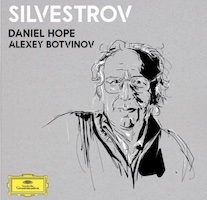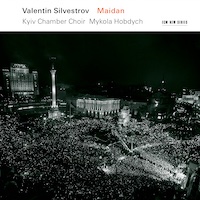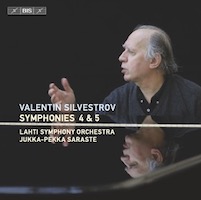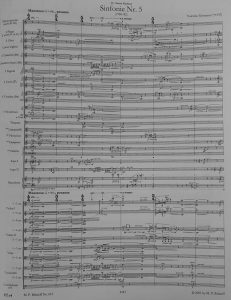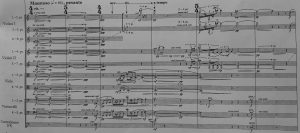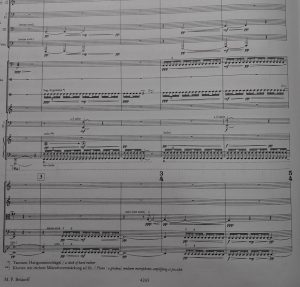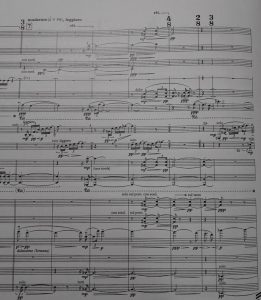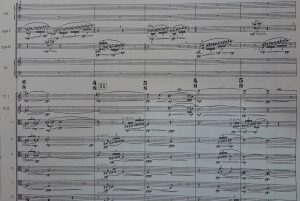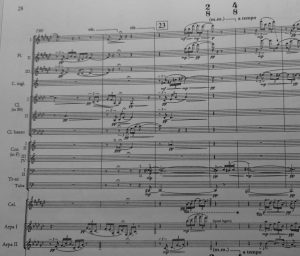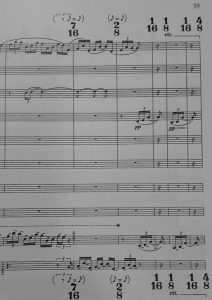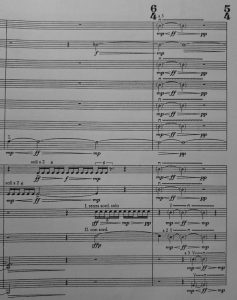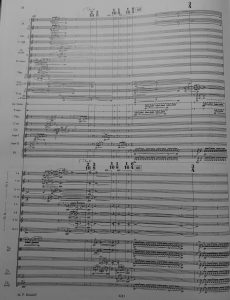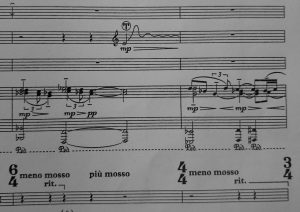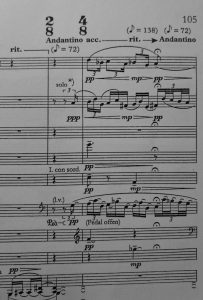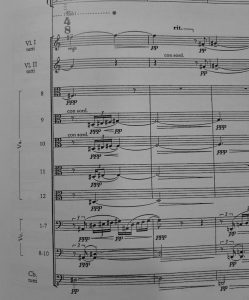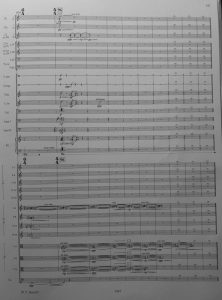Silvestrov in 2022 / Mostly Symphonies 42.
|
Grant Chu Covell [November 2022.]
“Silvestrov.” Valentin SILVESTROV: Melodies of the Moments: Cycle III: Three Pieces (2005); Nostalghia (2001); Melodies of the Moments: Cycle VII: Songs Without Words (2004); Moments of Chopin (2003); Hommage à J. S. B. (2009); Melodies of the Moments: Cycle VI: 25.10.1893 …in Memoriam P. I. Tsch. (2004); Pastorales 2020 (2020). Daniel Hope (vln), Alexey Botvinov (pno). DG 00028948637317 (1 CD) (www.deutschegrammophon.com). The thing is, we take Silvestrov’s nostalgic, weepy pieces differently now that he is an exile in Germany. Hope and Botvinov had planned to work on this release with Silvestrov in Ukraine in early 2022, but the composer had to flee. This recording was made in Berlin, in March and April of 2022. It’s nearly an hour of syrup for violin and piano. As straightforward as these short pieces can be, they are nonetheless precisely detailed in terms of tempo (speeding and slowing often specified within the same measure), and few notes are without dynamic markings. The music ought to sound effortless, but the specifics of how to articulate each pitch and how the rubato should land is not up to chance or a performer’s whim. Elsewhere I had thought Silvestrov was conjuring Mozart (and he does in some pieces), but overall, perhaps now we should be thinking of old Ukrainian (or even Russian) tunes. What do the titles tell us? These are memories, lullabies, elegies, homages, reflections of people long gone. They also place us within the Classical tradition: Silvestrov rubs shoulders with Chopin, Bach, Tchaikovsky and Beethoven. Nostalghia and Moments of Chopin offer piano alone. Pastorales 2020 starts from a hint of Beethoven’s Sixth and wanders sweetly and gently. (I couldn’t get into Hope and Botvinov’s recent release of Schnittke [DG 00028948392346]. Schnittke and Silvestrov are different but related, post-Soviet iconoclasts and post-Modern rummagers, chroniclers of worlds sliding away.)
“Maidan.” Valentin SILVESTROV: Maidan 2014 (Cycle of cycles) (2014); Four Songs (2014); Diptych (2016); Triptych (2015). Kyiv Chamber Choir, Mykola Hobdych (cond.). ECM 2359 (1 CD) (www.ecmrecords.com). ECM, who has presented Silvestrov for years, offers Maidan, a timely choral release, recorded in 2016, in Kyiv. Silvestrov put together these songs in the aftermath of the “Euromaidan,” the demonstrations that arrived in Ukraine in 2014. Containing settings by Taras Shevchencko, bits of the National Anthem and liturgical texts, these tonal pieces resonate thickly. Rachmaninoff’s Vespers come to mind very quickly. Silvestrov is quoted in ECM’s materials: “…I’m neither able nor willing to duplicate the noise of this terrible war. Instead, I want to show how fragile our civilization is. I try, with my music, to safeguard and preserve a day of peace.” Yes, civilization is capable of great delicacy. The music isn’t necessarily milquetoast. The chorus has power, and can convey or instruct, soothe or warn. I am not a fan of choral music. I hesitate to call these settings transformational. But like Rachmaninoff’s Vespers, the collection becomes something larger, touching upon something eternal. ECM does not tell us much about where the chorus is today. We have merely these snapshots from 2016.
Valentin SILVESTROV: Symphony No. 4 (1976); Symphony No. 5 (1980-82). Lahti Symphony Orchestra, Jukka-Pekka Saraste (cond.). BIS 1703 (1 CD) (www.bis.se). Honestly, I rather encourage a closer look at Symphony No. 5. Silvestrov has penned a total of nine symphonies at present. With his Fifth, his style took a turn closer to what we’re accustomed to today. He calls it a “metaphorical style” or “meta-music.” There are several recordings of No 5. (Recordings of the other symphonies are fewer.) This BIS release is perhaps the most accurate, and was recorded in January 2008 and released in 2009. (This BIS release starts with the shorter Symphony No. 4, clearly by the same hand, however a single-minded utterance. No. 4 is meaner, with apocalyptic brushes, whereas the larger No. 5 overtly flirts with Romanticism and balances greater contrasts.) Silvestrov’s Fifth starts with a shudder and then an unravelling before plunging into a warm Romantic bath. Mahler is the clear progenitor, but there are no explicit quotes, merely a consummate handling of melody and harmony. Silvestrov spins an aching melody orchestrated like Mahler, but the reference is probably something Ukrainian or Russian. The orchestral shuddering interrupts the reverie, and the cycle ebbs and flows across slightly more than forty minutes. Silvestrov generously explores his material, contrasting brassy dissonance with lovely filigree in winds and harp. Instruments take specific roles: a magisterial solo violin, the trombone chorale that never quite lifts off, the pastoral clarinet. The music flows naturally, even though the score is constantly changing meter, adding extra fractions of measures for a precisely specified sigh or suspension. Symphony No. 5 is scored for large orchestra: three flutes (1. doubles alto flute and 3. doubles piccolo), two oboes, English horn, two clarinets, bass clarinet, three bassoons, four horns, three trumpets, three trombones, tuba, five percussionists (timpani, bells, vibraphone, bass drum, tamtam, gong), celeste, two harps, piano (amplified), strings (30 violins, 12 violas, 10 cellos and 8 basses). The score is published by M. P. Belaieff. The first page. BIS’ notes suggest Silvestrov took inspiration from Scriabin’s incomplete Mysterium. Considering Alexander Nemtin’s elaboration, we have similar openings: Stormy chords, then agitation rising from the depths. Silvestrov tosses out a few clusters, a rapid line, several suspended notes before settling into a tonality. The opening bars could have also leaned towards serialism. Note the number of tempo changes in just the first 3 measures (Page 1). The shudder at the opening. Note the precise indication for the piano’s de-amplification (Page 4). The tritone (F#-C) as signal (Page 10). Notwithstanding the meter changes and the harmony, here is a bit which suggests Mahler’s Adagietto (Page 13). The trombones (Tr-ni) and tuba attempt to start a chorale (Page 28). An example of metric complexity and added 1/16 measures (Page 39). The ritardando and the 1/16 measure could also have been written differently, perhaps appended to the previous 1/8 measure and filled out to 2/8, but Silvestrov is being precise, perhaps stubborn. Incorporating a bit of extended technique, the winds are instructed to breathe through their instruments (Page 69). The effect is quite natural, but a passage of 4/4 2/16 3/8 1/16 1/8 1/16 6/4 is unexpected in a Romantic sounding work (Page 78). The opening shudder reappears as well. The piano offers something very sentimental, almost schlock, while the harp is instructed to “slide a metal rod (key) over the strings as indicated by the curves” (Page 81). An example of the bucolic clarinet solo (second line). Note the precisely specified tempo changes (Page 105). An example of the strings sustaining all the notes in a motive to create clusters (Page 131). The final page, barely audible (Page 141). It is unexpected to associate sentimentality with complexity. The symphony seems simple and casual but it is suffused with impressive details. It may be hard to hear that each note of a feathery melody is sustained by a string player, creating thick gauze. Besides the meticulous detail and complex changes of meter, Silvestrov asks for avant-garde effects of wind players breathing through mouthpieces. There is nothing spontaneous about this music. (I may have my own obsessions, but this time through, I heard many similarities with Ferrari’s Histoire du Plaisir et de la Désolation: Using tritones as anchors, the clarinets presenting rustic tunes, metric instability as ideas develop, etc.) Presuming we still value symphonies, Silvestrov has written one of the 20th-century’s mightiest examples. Peeling back the nostalgia, we can imagine someone engaged in a mundane household task, humming a tune, maybe Mozart or an old Ukrainian melody, trying to recall something once heard while war rages close by. Beautiful things slipping away, and constant reminders of better times.
[More Grant Chu Covell, Mostly Symphonies]
[More
Silvestrov]
[Previous Article:
A Ramble, Fairly Eclectic, with Turntables]
[Next Article:
Dvořák’s Prophecy, Shostakovich as Cure and Beethoven in Boston]
|
